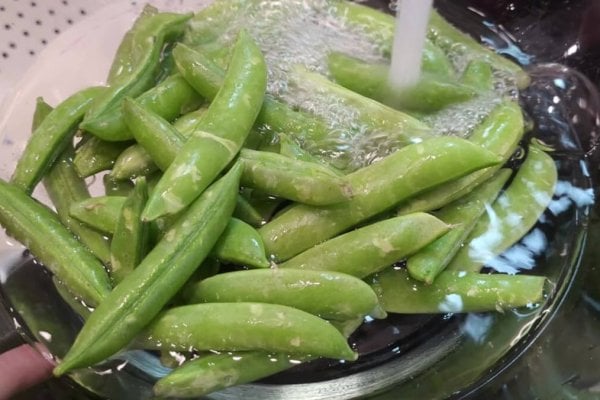Did you know that raw milk contains essential nutrients such as vitamins, minerals, and beneficial bacteria? (Source) You can take advantage of all of these benefits when you learn how to process raw milk properly.

Read on to learn how to safely and easily process fresh cow’s milk at home so that you can enjoy delicious homemade dairy products while minimizing the risk of contamination.
Table of Contents
ToggleThe Importance of Processing Milk
We always strive to make homemade dairy practical and sustainable for the average homesteader. Straining fresh milk offers several benefits, including enhanced texture, improved taste and increased versatility. When you strain the milk, you’ll remove any lumps, curds, or unwanted particles, resulting in a smoother and more enjoyable texture.
Strained fresh milk tends to have a cleaner and fresher taste, free from any off-flavors caused by impurities. Have you ever wondered what to do with raw milk? Once your milk has been strained, you can use it as a base for various dairy products such as homemade yogurt cheese, butter, yogurt, or any of these recipes that use up a lot of milk.
Perhaps one of our favorite ways to use up excess milk is to make our homemade ice cream recipe for the ice cream maker. You can also freeze or freeze-dry milk to use at a future date.

Safety Tips for Processing Raw Milk
Processing raw milk at home allows you to tap into the natural goodness of fresh milk straight from the source. (Source) However, it’s important to be aware of the potential risks and take necessary precautions to maintain the highest standards of hygiene and safety.
- Source High-Quality Raw Milk – It’s not realistic for all homesteaders to own a milk cow, so it’s important to find a reliable and reputable source. Look for a local farm or dairy that follows proper practices for milk production and handling. Make sure that the animals are healthy and well-cared for and that the milking process is hygienic.
- Maintain Strict Hygiene – Hygiene is of utmost importance when handling raw milk. Before starting the process, wash your hands thoroughly with soap and water. Clean all the utensils, equipment, and surfaces that will come into contact with the milk. This helps prevent the introduction of harmful bacteria into your final product.
- Do Not Skip Steps – On a busy day, it may be tempting to skip a processing step. This will inevitably result in a compromised flavor or shortened shelf life of your milk.
- Store the Processed Milk Correctly – Once you have processed the raw milk, it’s important to store it properly to maintain its freshness and quality. Use clean, airtight containers to prevent contamination and store the milk in the refrigerator at a temperature below 40°F (4°C).

Supplies Needed
Before processing your raw milk, make sure you have all your supplies gathered and ready for use.
- Stainless Steel Pail – We have just one dairy cow (and a couple of Nubian goats), so we find hand milking is easier and more efficient. Our cow produces about 3 gallons of milk per milking, making a five-gallon pail the perfect size.
- ½ Gallon Mason Jars & Lids – Gallon jars can also be used, but we like the half-gallon jars because they are easier for smaller hands to handle. Unless you are processing your milk to sell, sterilizing your jars is not necessary. Thoroughly cleaning them with hot, soapy water is sufficient for private consumption.
- Funnel – Do not use a plastic funnel. Plastic holds onto bacteria over time and will contaminate your fresh milk. Always use a stainless steel funnel instead.
- Filters – We do our best to find reusable options to work towards a zero-waste home, but in this case, we have found that reusable filters don’t last long-term, and disposable paper filters are a better option.
- Ladle – A good-sized ladle makes transferring milk from the pail to the jars easier than pouring directly from the pail.
- Marking Pen – There’s a reason Sharpie pens are one of my top homesteading essentials! They work great for so many homesteading tasks, including marking the date directly on the milk jar because the ink easily washes off between uses.
- Gravy Ladle and Spoon – I have found this combination to be the best tool for skimming the cream off your milk. If you don’t have a gravy ladle, two metal spoons work too.

How to Process Raw Milk at Home
Processing fresh cow’s and/or goat’s milk at home is a relatively simple process that takes us about 30 minutes a day (including setup, teardown, and cleaning your tools and containers). If you’re new to the process, expect it to take a bit longer at first. Before long, you’ll find your routine, and it will take less time.
- Prepare the jars and lids needed by thoroughly washing them with hot, soapy water and having them ready to fill.
- Line the funnel with a filter and place it in the first clean jar.
- Using a ladle, transfer the milk to the jar, allowing the filter to catch any contaminants.
- Once the first jar is full, transfer the filter to the next jar and repeat step 3 until all of the milk has been filtered.
- Mark the jar with the date. Homesteading Hack: If you do morning and evening milkings, mark your date with AM or PM accordingly.
- Set the lids on the jars and place them immediately in the refrigerator for cooling. Homesteading Hack: Don’t screw the lids down tight. Leaving a crack allowing the heat from the milk to escape will cool the milk faster, giving it a longer shelf life. Let the milk sit in your fridge for at least thirty minutes before coming back to tighten the lid down.
- Allow the milk to chill for about 24 hours to allow the cream to rise to the top. Homesteading Hack: Goat’s milk is naturally homogenized, so you won’t be able to skim the cream off the goat’s milk right away. If you have the patience to wait 3-7 days for it to naturally separate, you can go this route, or you’ll need to purchase a cream separator (or just enjoy your full-fat goat’s milk as is).
- Remove the chilled milk from the refrigerator.
- Prepare a clean jar for the cream, and label it to easily identify it from your milk jars.
- Using a gravy ladle (or spoon), skim the cream off your milk and transfer it to a clean jar. If the cream tries to stick to the ladle, use the second spoon to scrape the cream off the ladle. Homesteading Hack: If you wet your ladle and spoon before skimming your cream, the cream will slide off easier when transferring it to the other jar.
- Repeat step 10 until all the cream is removed. You will be able to tell the difference between the milk and cream by the color. The milk will have a slightly blue color to it in comparison to the cream. Homesteading Hack: Try to avoid adding milk to your cream jar. The milk will cause the cream to sour more quickly.
- Place lids on the jars and return back to the refrigerator for proper storage.
- Continue to add cream to your jar day after day until you are ready to use it for clotted cream, homemade butter, ice cream, etc.

How to Properly Store Raw Milk
Proper storage is crucial to maintain the freshness and quality of raw milk. After processing, it’s essential to store it in the refrigerator to prevent bacterial growth.
| Storage Tips for Raw Milk |
|---|
| Strain the milk into a clean container, such as a glass jar. |
| Label the container with the date of processing to ensure freshness. |
| Immediately place the container in the coldest part of the refrigerator, ideally below 40°F (4°C). |
| Avoid storing raw milk near strong-smelling food items, as it may absorb odors. |
| Allow the jars of milk to vent in the refrigerator for at least 30 minutes before tightening the lids. |
| Consume the raw milk within 7 to 10 days for optimal taste and quality. |

Practical Homemade Dairy Masterclass
Now that you know how easy it is to process raw milk at home, are you ready to make homemade dairy products with your fresh milk and cream? The Practical Homemade Dairy Masterclass teaches you how to make all of your own dairy products, even if you don’t own a dairy cow!
In this class, you will learn…
- Set Up – Learn what equipment and supplies you actually need.
- Pasteurization – Learn when pasteurization is necessary for certain dairy products and how to pasteurize your raw milk safely.
- Cultured Dairy – Cultured dairy is the foundation for all of your delectable dairy products – from yogurt, buttermilks and sour creams to soft and hard cheeses.
- Cheesemaking – Learn the simple, straightforward process I use to create easy soft cheeses all the way through to advanced, hard cheeses that can be aged.
- Putting it All Together – Dairy doesn’t have to be complicated! Learn to practically make dairy products in your home in just a few hours a week.
Sign up to receive instant access today!
FAQ
Processing milk is crucial because it helps eliminate contaminants that can affect the flavor and shelf life of raw milk.
Yes, you can definitely process raw milk at home. Processing your own raw milk allows you to have better control over the quality and freshness of your dairy products. Just make sure to follow the proper steps to ensure the safety of the end product.
To ensure the safety of raw milk, it’s important to obtain your milk from a trusted source, practice proper hygiene during milk collection, and implement appropriate processing and storage techniques. By following these guidelines, you can reduce the risk of consuming contaminated raw milk.

Other Posts You May Enjoy
- Homemade Chevre Cheese (Goat’s Milk Cheese)
- Making Homemade Dairy Products Practical
- How to Freeze Milk (Or Freeze-Dry Milk)
- How to Make Kefir
- Raw Milk Cottage Cheese (Easy Step-by-Step Tutorial)
- Can You Make Cheese From Store-Bought Milk?
- Easy Instant Pot Yogurt Recipe (Step-by-Step)
- Vanilla Ice Cream Recipe


















